Finance Report: Ratio Analysis, Investment Appraisal Techniques
VerifiedAdded on 2023/01/06
|19
|4048
|39
Report
AI Summary
This finance report delves into the financial performance of Tesco plc and Sainsbury's plc through comprehensive ratio analysis. The report examines key financial ratios, including current ratio, quick ratio, net profit margin, gross profit margin, gearing ratio, price-to-earnings ratio, earnings per share, return on capital employed, inventory turnover, and dividend payout ratio, providing detailed interpretations and comparisons between the two companies over a two-year period. The report also discusses the limitations of ratio analysis and the importance of investment appraisal techniques in making informed investment decisions. Furthermore, the report offers recommendations for improving financial performance based on the ratio analysis findings. The second part of the report also covers investment appraisal techniques and their limitations in long-term decision making. The report concludes with a summary of the key findings and recommendations.
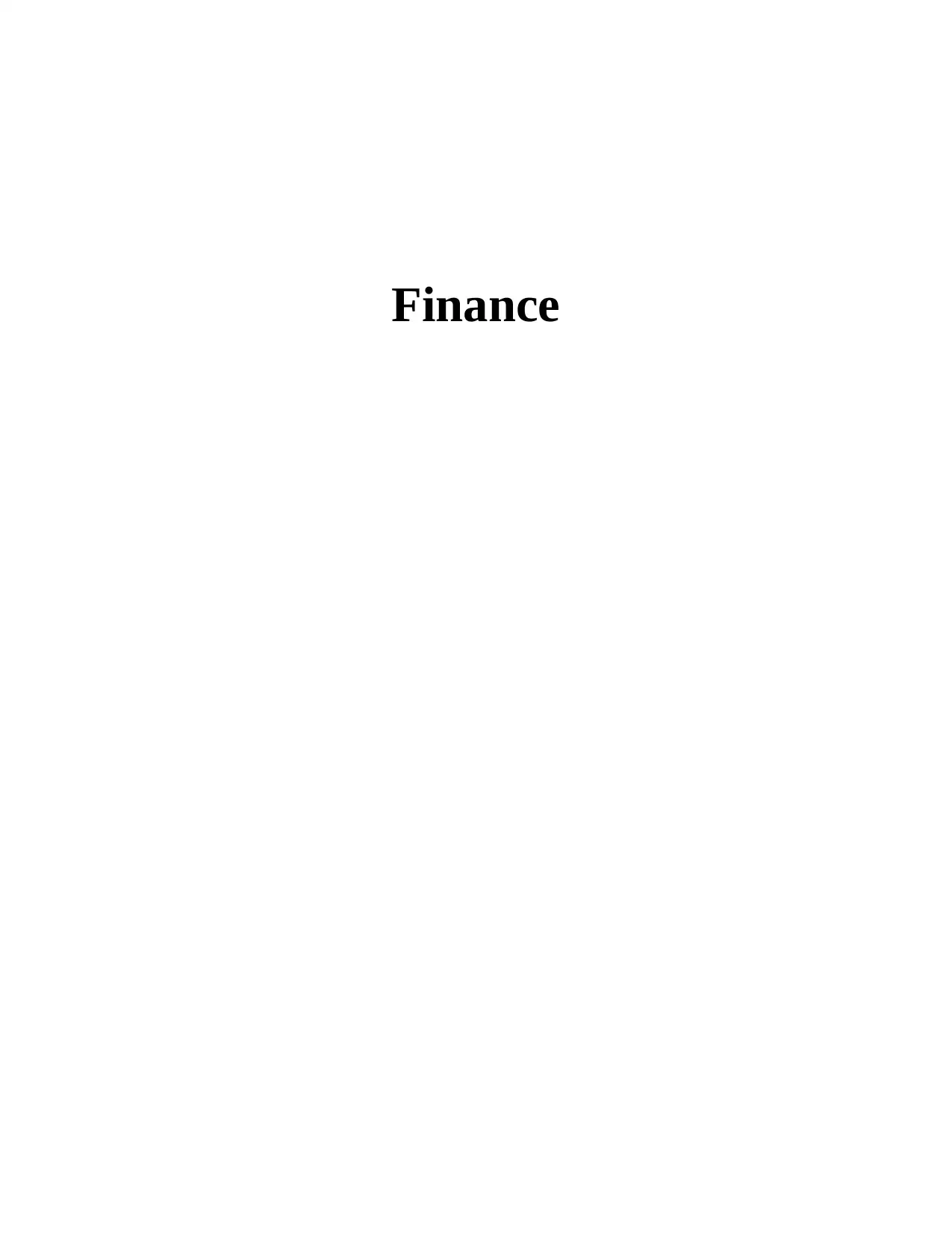
Finance
Paraphrase This Document
Need a fresh take? Get an instant paraphrase of this document with our AI Paraphraser
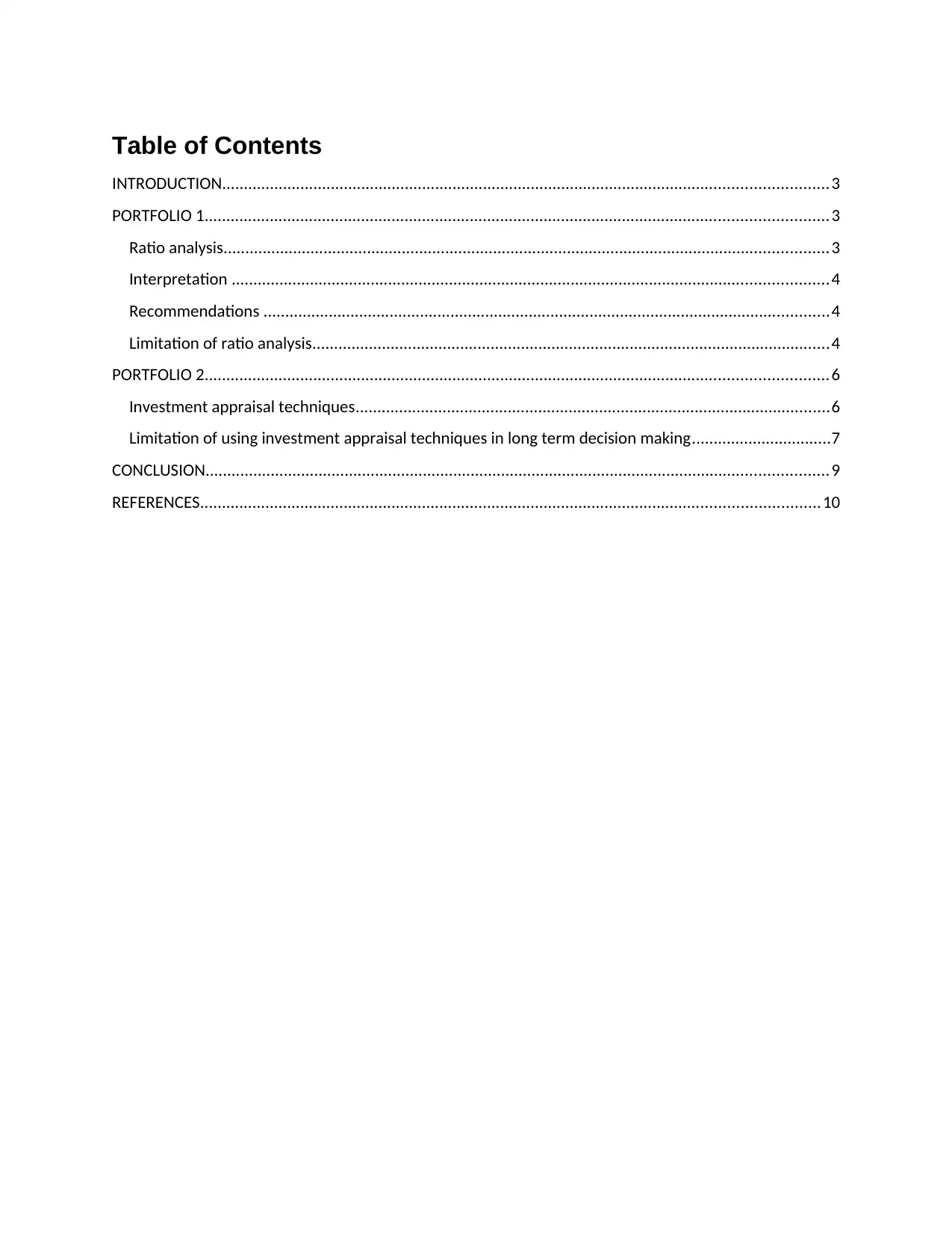
Table of Contents
INTRODUCTION...........................................................................................................................................3
PORTFOLIO 1...............................................................................................................................................3
Ratio analysis...........................................................................................................................................3
Interpretation .........................................................................................................................................4
Recommendations ..................................................................................................................................4
Limitation of ratio analysis.......................................................................................................................4
PORTFOLIO 2...............................................................................................................................................6
Investment appraisal techniques.............................................................................................................6
Limitation of using investment appraisal techniques in long term decision making................................7
CONCLUSION...............................................................................................................................................9
REFERENCES..............................................................................................................................................10
INTRODUCTION...........................................................................................................................................3
PORTFOLIO 1...............................................................................................................................................3
Ratio analysis...........................................................................................................................................3
Interpretation .........................................................................................................................................4
Recommendations ..................................................................................................................................4
Limitation of ratio analysis.......................................................................................................................4
PORTFOLIO 2...............................................................................................................................................6
Investment appraisal techniques.............................................................................................................6
Limitation of using investment appraisal techniques in long term decision making................................7
CONCLUSION...............................................................................................................................................9
REFERENCES..............................................................................................................................................10
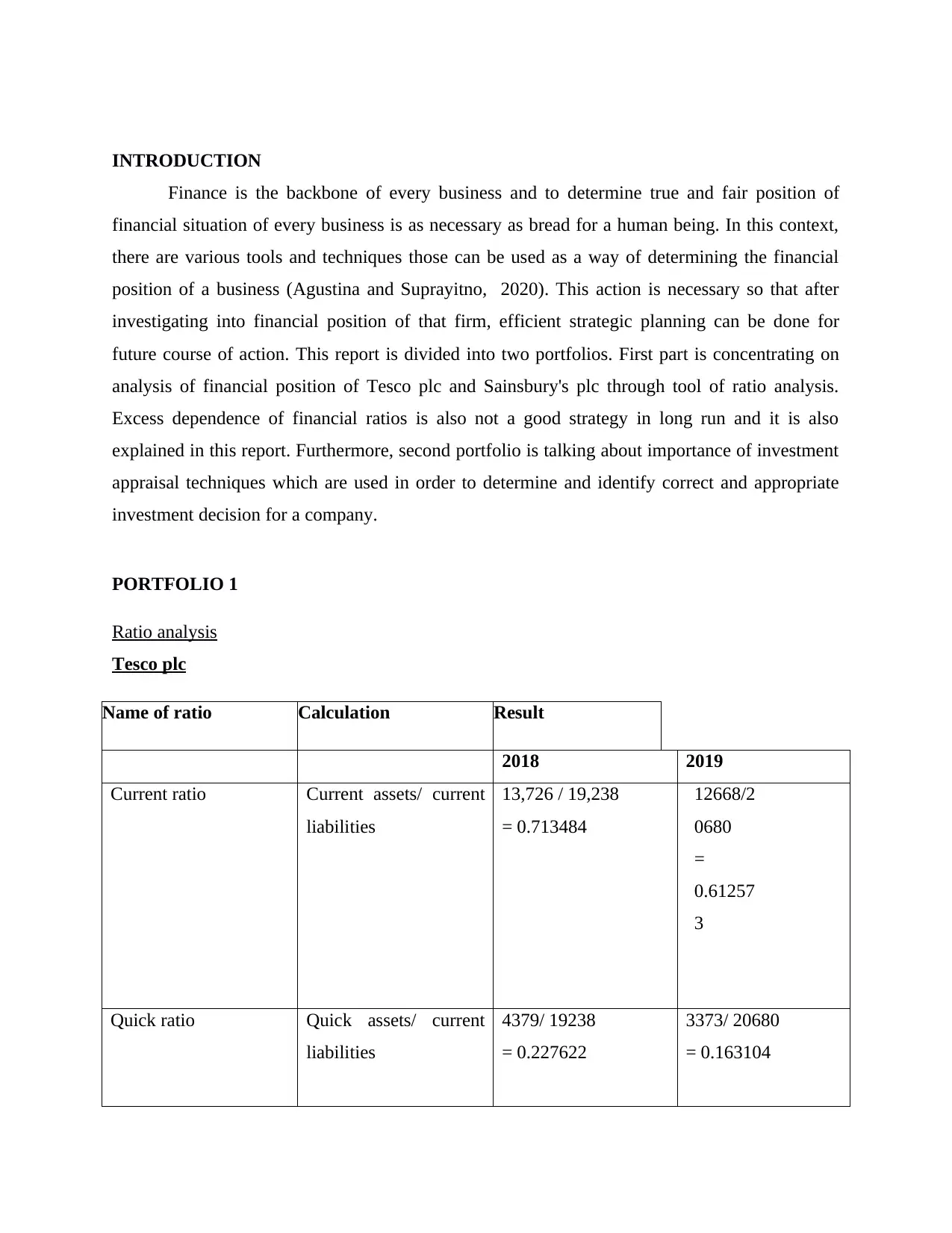
INTRODUCTION
Finance is the backbone of every business and to determine true and fair position of
financial situation of every business is as necessary as bread for a human being. In this context,
there are various tools and techniques those can be used as a way of determining the financial
position of a business (Agustina and Suprayitno, 2020). This action is necessary so that after
investigating into financial position of that firm, efficient strategic planning can be done for
future course of action. This report is divided into two portfolios. First part is concentrating on
analysis of financial position of Tesco plc and Sainsbury's plc through tool of ratio analysis.
Excess dependence of financial ratios is also not a good strategy in long run and it is also
explained in this report. Furthermore, second portfolio is talking about importance of investment
appraisal techniques which are used in order to determine and identify correct and appropriate
investment decision for a company.
PORTFOLIO 1
Ratio analysis
Tesco plc
Name of ratio Calculation Result
2018 2019
Current ratio Current assets/ current
liabilities
13,726 / 19,238
= 0.713484
12668/2
0680
=
0.61257
3
Quick ratio Quick assets/ current
liabilities
4379/ 19238
= 0.227622
3373/ 20680
= 0.163104
Finance is the backbone of every business and to determine true and fair position of
financial situation of every business is as necessary as bread for a human being. In this context,
there are various tools and techniques those can be used as a way of determining the financial
position of a business (Agustina and Suprayitno, 2020). This action is necessary so that after
investigating into financial position of that firm, efficient strategic planning can be done for
future course of action. This report is divided into two portfolios. First part is concentrating on
analysis of financial position of Tesco plc and Sainsbury's plc through tool of ratio analysis.
Excess dependence of financial ratios is also not a good strategy in long run and it is also
explained in this report. Furthermore, second portfolio is talking about importance of investment
appraisal techniques which are used in order to determine and identify correct and appropriate
investment decision for a company.
PORTFOLIO 1
Ratio analysis
Tesco plc
Name of ratio Calculation Result
2018 2019
Current ratio Current assets/ current
liabilities
13,726 / 19,238
= 0.713484
12668/2
0680
=
0.61257
3
Quick ratio Quick assets/ current
liabilities
4379/ 19238
= 0.227622
3373/ 20680
= 0.163104
⊘ This is a preview!⊘
Do you want full access?
Subscribe today to unlock all pages.

Trusted by 1+ million students worldwide
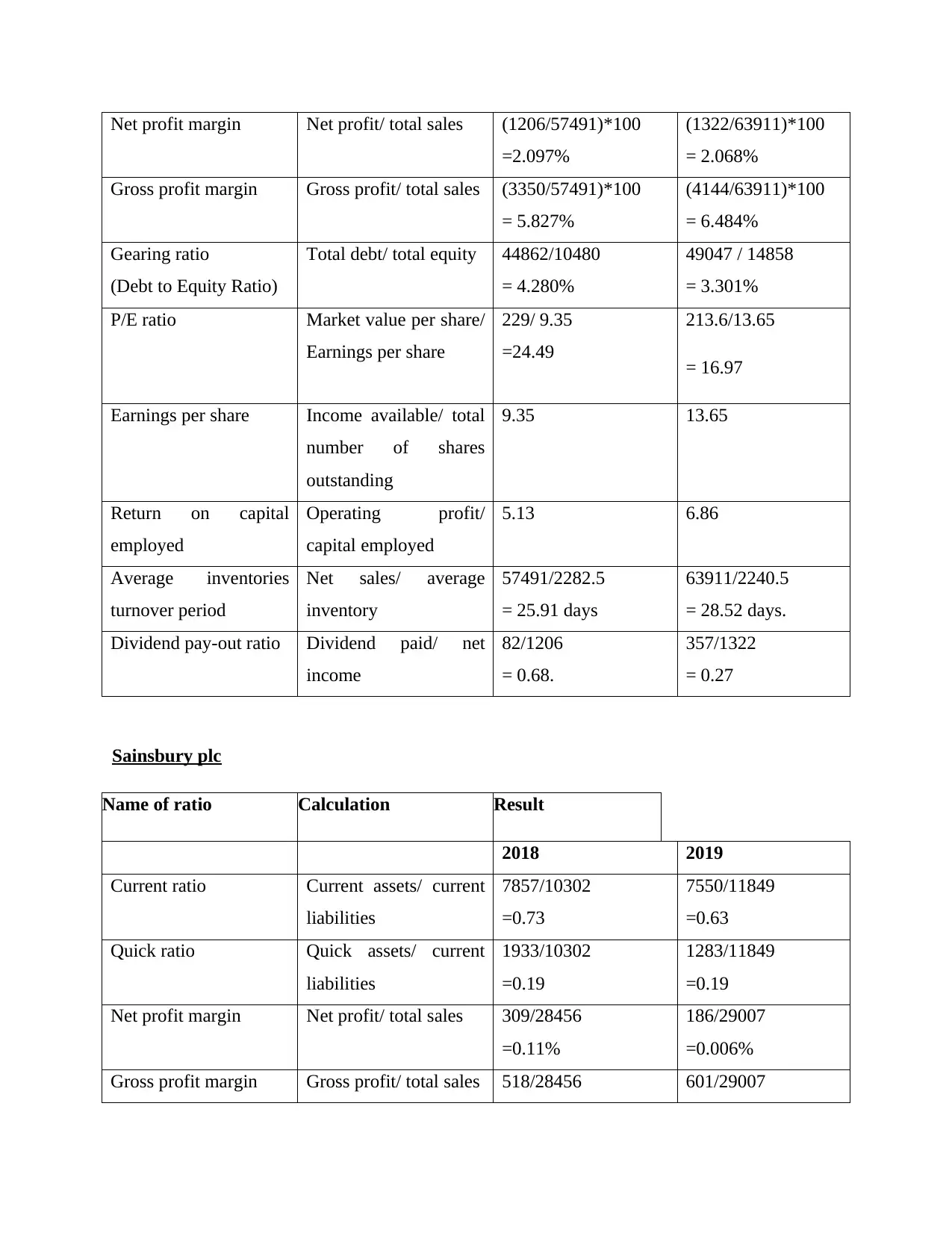
Net profit margin Net profit/ total sales (1206/57491)*100
=2.097%
(1322/63911)*100
= 2.068%
Gross profit margin Gross profit/ total sales (3350/57491)*100
= 5.827%
(4144/63911)*100
= 6.484%
Gearing ratio
(Debt to Equity Ratio)
Total debt/ total equity 44862/10480
= 4.280%
49047 / 14858
= 3.301%
P/E ratio Market value per share/
Earnings per share
229/ 9.35
=24.49
213.6/13.65
= 16.97
Earnings per share Income available/ total
number of shares
outstanding
9.35 13.65
Return on capital
employed
Operating profit/
capital employed
5.13 6.86
Average inventories
turnover period
Net sales/ average
inventory
57491/2282.5
= 25.91 days
63911/2240.5
= 28.52 days.
Dividend pay-out ratio Dividend paid/ net
income
82/1206
= 0.68.
357/1322
= 0.27
Sainsbury plc
Name of ratio Calculation Result
2018 2019
Current ratio Current assets/ current
liabilities
7857/10302
=0.73
7550/11849
=0.63
Quick ratio Quick assets/ current
liabilities
1933/10302
=0.19
1283/11849
=0.19
Net profit margin Net profit/ total sales 309/28456
=0.11%
186/29007
=0.006%
Gross profit margin Gross profit/ total sales 518/28456 601/29007
=2.097%
(1322/63911)*100
= 2.068%
Gross profit margin Gross profit/ total sales (3350/57491)*100
= 5.827%
(4144/63911)*100
= 6.484%
Gearing ratio
(Debt to Equity Ratio)
Total debt/ total equity 44862/10480
= 4.280%
49047 / 14858
= 3.301%
P/E ratio Market value per share/
Earnings per share
229/ 9.35
=24.49
213.6/13.65
= 16.97
Earnings per share Income available/ total
number of shares
outstanding
9.35 13.65
Return on capital
employed
Operating profit/
capital employed
5.13 6.86
Average inventories
turnover period
Net sales/ average
inventory
57491/2282.5
= 25.91 days
63911/2240.5
= 28.52 days.
Dividend pay-out ratio Dividend paid/ net
income
82/1206
= 0.68.
357/1322
= 0.27
Sainsbury plc
Name of ratio Calculation Result
2018 2019
Current ratio Current assets/ current
liabilities
7857/10302
=0.73
7550/11849
=0.63
Quick ratio Quick assets/ current
liabilities
1933/10302
=0.19
1283/11849
=0.19
Net profit margin Net profit/ total sales 309/28456
=0.11%
186/29007
=0.006%
Gross profit margin Gross profit/ total sales 518/28456 601/29007
Paraphrase This Document
Need a fresh take? Get an instant paraphrase of this document with our AI Paraphraser
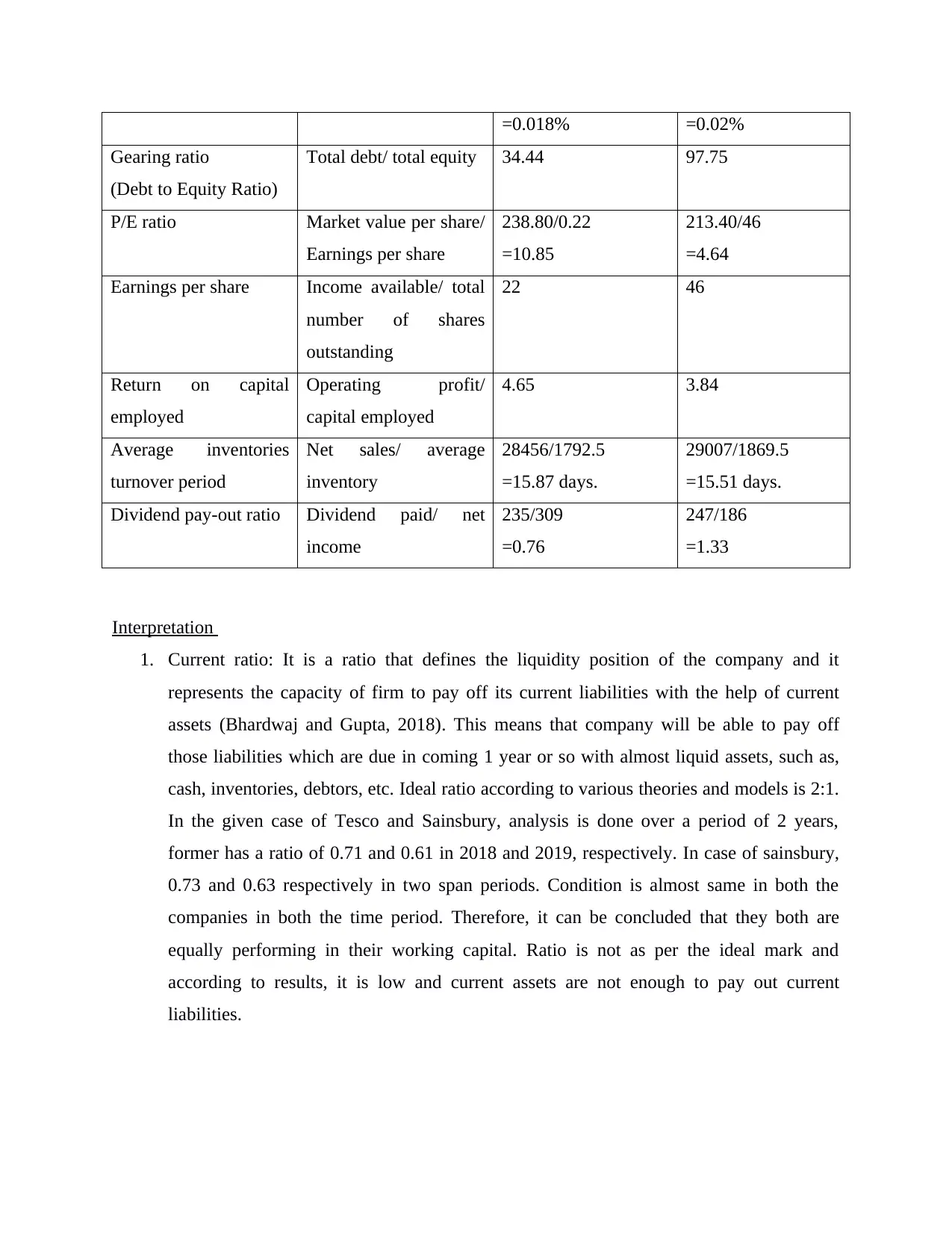
=0.018% =0.02%
Gearing ratio
(Debt to Equity Ratio)
Total debt/ total equity 34.44 97.75
P/E ratio Market value per share/
Earnings per share
238.80/0.22
=10.85
213.40/46
=4.64
Earnings per share Income available/ total
number of shares
outstanding
22 46
Return on capital
employed
Operating profit/
capital employed
4.65 3.84
Average inventories
turnover period
Net sales/ average
inventory
28456/1792.5
=15.87 days.
29007/1869.5
=15.51 days.
Dividend pay-out ratio Dividend paid/ net
income
235/309
=0.76
247/186
=1.33
Interpretation
1. Current ratio: It is a ratio that defines the liquidity position of the company and it
represents the capacity of firm to pay off its current liabilities with the help of current
assets (Bhardwaj and Gupta, 2018). This means that company will be able to pay off
those liabilities which are due in coming 1 year or so with almost liquid assets, such as,
cash, inventories, debtors, etc. Ideal ratio according to various theories and models is 2:1.
In the given case of Tesco and Sainsbury, analysis is done over a period of 2 years,
former has a ratio of 0.71 and 0.61 in 2018 and 2019, respectively. In case of sainsbury,
0.73 and 0.63 respectively in two span periods. Condition is almost same in both the
companies in both the time period. Therefore, it can be concluded that they both are
equally performing in their working capital. Ratio is not as per the ideal mark and
according to results, it is low and current assets are not enough to pay out current
liabilities.
Gearing ratio
(Debt to Equity Ratio)
Total debt/ total equity 34.44 97.75
P/E ratio Market value per share/
Earnings per share
238.80/0.22
=10.85
213.40/46
=4.64
Earnings per share Income available/ total
number of shares
outstanding
22 46
Return on capital
employed
Operating profit/
capital employed
4.65 3.84
Average inventories
turnover period
Net sales/ average
inventory
28456/1792.5
=15.87 days.
29007/1869.5
=15.51 days.
Dividend pay-out ratio Dividend paid/ net
income
235/309
=0.76
247/186
=1.33
Interpretation
1. Current ratio: It is a ratio that defines the liquidity position of the company and it
represents the capacity of firm to pay off its current liabilities with the help of current
assets (Bhardwaj and Gupta, 2018). This means that company will be able to pay off
those liabilities which are due in coming 1 year or so with almost liquid assets, such as,
cash, inventories, debtors, etc. Ideal ratio according to various theories and models is 2:1.
In the given case of Tesco and Sainsbury, analysis is done over a period of 2 years,
former has a ratio of 0.71 and 0.61 in 2018 and 2019, respectively. In case of sainsbury,
0.73 and 0.63 respectively in two span periods. Condition is almost same in both the
companies in both the time period. Therefore, it can be concluded that they both are
equally performing in their working capital. Ratio is not as per the ideal mark and
according to results, it is low and current assets are not enough to pay out current
liabilities.
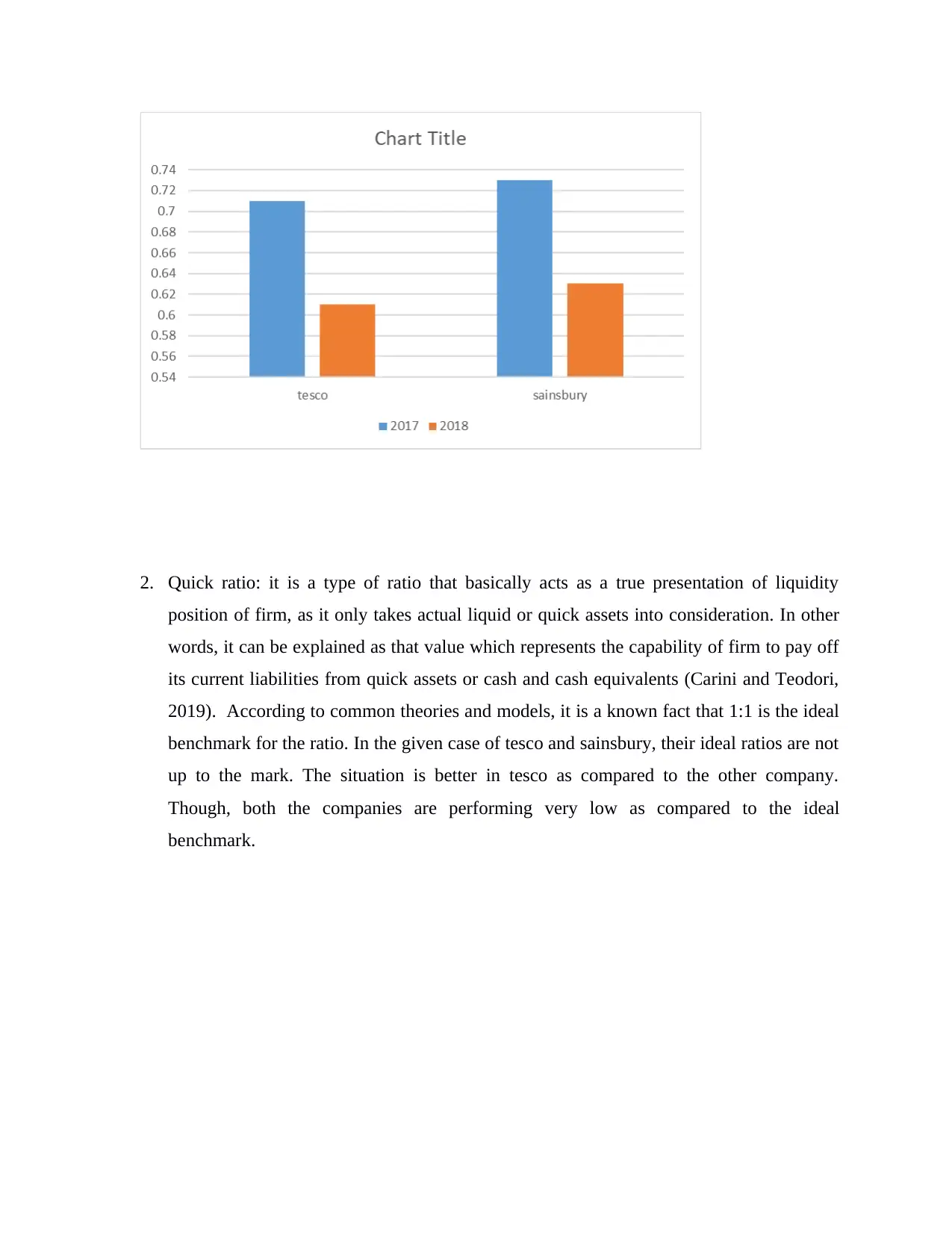
2. Quick ratio: it is a type of ratio that basically acts as a true presentation of liquidity
position of firm, as it only takes actual liquid or quick assets into consideration. In other
words, it can be explained as that value which represents the capability of firm to pay off
its current liabilities from quick assets or cash and cash equivalents (Carini and Teodori,
2019). According to common theories and models, it is a known fact that 1:1 is the ideal
benchmark for the ratio. In the given case of tesco and sainsbury, their ideal ratios are not
up to the mark. The situation is better in tesco as compared to the other company.
Though, both the companies are performing very low as compared to the ideal
benchmark.
position of firm, as it only takes actual liquid or quick assets into consideration. In other
words, it can be explained as that value which represents the capability of firm to pay off
its current liabilities from quick assets or cash and cash equivalents (Carini and Teodori,
2019). According to common theories and models, it is a known fact that 1:1 is the ideal
benchmark for the ratio. In the given case of tesco and sainsbury, their ideal ratios are not
up to the mark. The situation is better in tesco as compared to the other company.
Though, both the companies are performing very low as compared to the ideal
benchmark.
⊘ This is a preview!⊘
Do you want full access?
Subscribe today to unlock all pages.

Trusted by 1+ million students worldwide
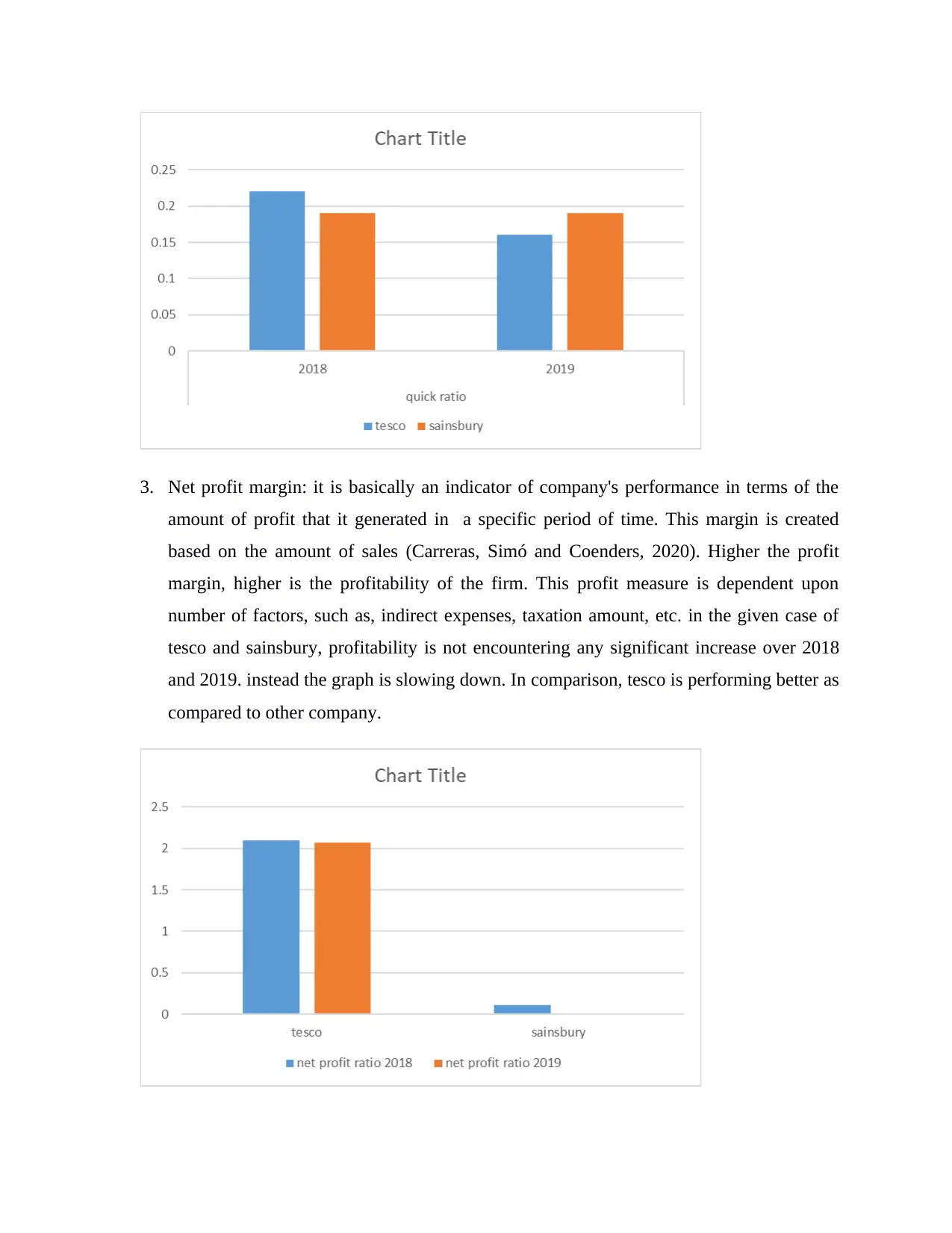
3. Net profit margin: it is basically an indicator of company's performance in terms of the
amount of profit that it generated in a specific period of time. This margin is created
based on the amount of sales (Carreras, Simó and Coenders, 2020). Higher the profit
margin, higher is the profitability of the firm. This profit measure is dependent upon
number of factors, such as, indirect expenses, taxation amount, etc. in the given case of
tesco and sainsbury, profitability is not encountering any significant increase over 2018
and 2019. instead the graph is slowing down. In comparison, tesco is performing better as
compared to other company.
amount of profit that it generated in a specific period of time. This margin is created
based on the amount of sales (Carreras, Simó and Coenders, 2020). Higher the profit
margin, higher is the profitability of the firm. This profit measure is dependent upon
number of factors, such as, indirect expenses, taxation amount, etc. in the given case of
tesco and sainsbury, profitability is not encountering any significant increase over 2018
and 2019. instead the graph is slowing down. In comparison, tesco is performing better as
compared to other company.
Paraphrase This Document
Need a fresh take? Get an instant paraphrase of this document with our AI Paraphraser
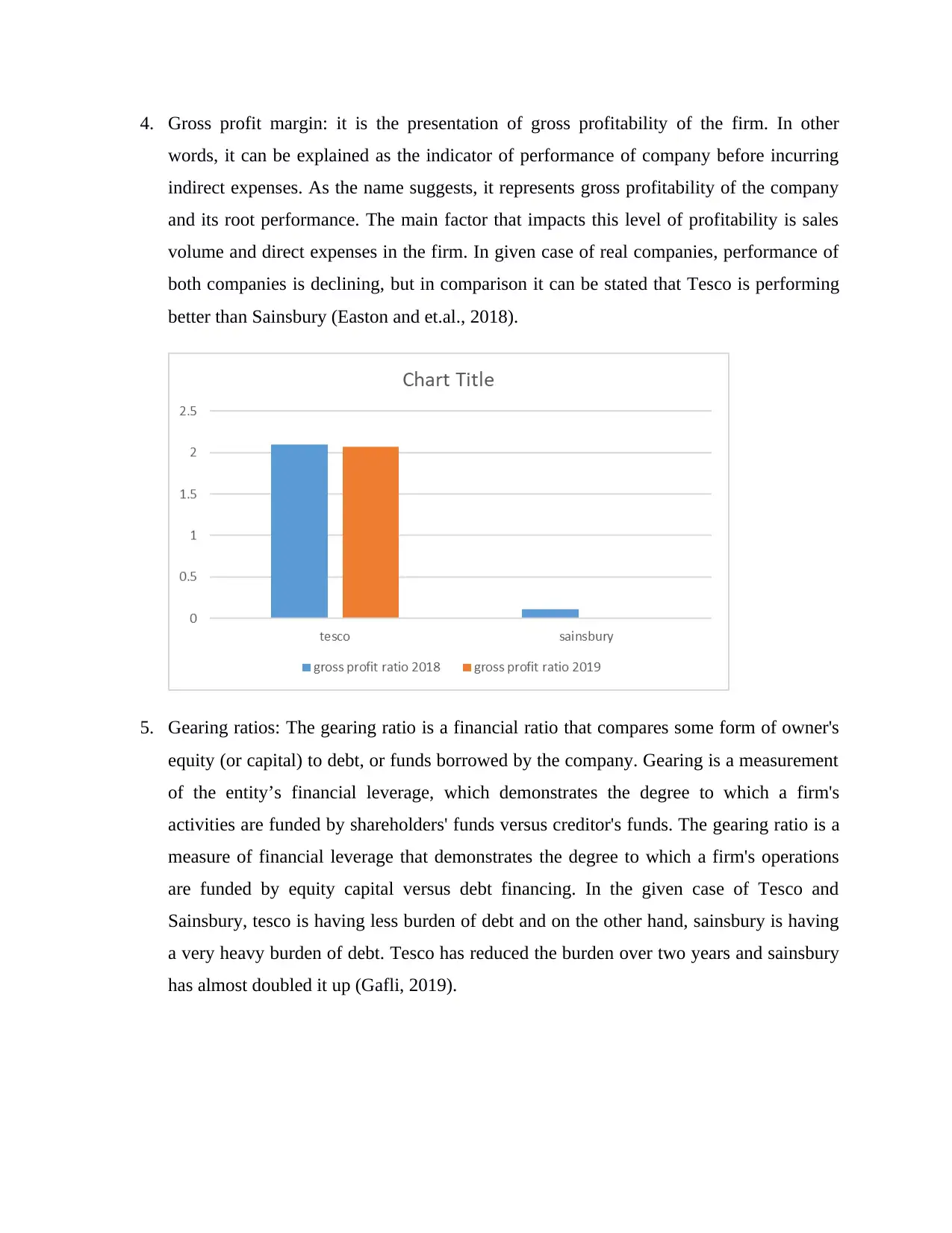
4. Gross profit margin: it is the presentation of gross profitability of the firm. In other
words, it can be explained as the indicator of performance of company before incurring
indirect expenses. As the name suggests, it represents gross profitability of the company
and its root performance. The main factor that impacts this level of profitability is sales
volume and direct expenses in the firm. In given case of real companies, performance of
both companies is declining, but in comparison it can be stated that Tesco is performing
better than Sainsbury (Easton and et.al., 2018).
5. Gearing ratios: The gearing ratio is a financial ratio that compares some form of owner's
equity (or capital) to debt, or funds borrowed by the company. Gearing is a measurement
of the entity’s financial leverage, which demonstrates the degree to which a firm's
activities are funded by shareholders' funds versus creditor's funds. The gearing ratio is a
measure of financial leverage that demonstrates the degree to which a firm's operations
are funded by equity capital versus debt financing. In the given case of Tesco and
Sainsbury, tesco is having less burden of debt and on the other hand, sainsbury is having
a very heavy burden of debt. Tesco has reduced the burden over two years and sainsbury
has almost doubled it up (Gafli, 2019).
words, it can be explained as the indicator of performance of company before incurring
indirect expenses. As the name suggests, it represents gross profitability of the company
and its root performance. The main factor that impacts this level of profitability is sales
volume and direct expenses in the firm. In given case of real companies, performance of
both companies is declining, but in comparison it can be stated that Tesco is performing
better than Sainsbury (Easton and et.al., 2018).
5. Gearing ratios: The gearing ratio is a financial ratio that compares some form of owner's
equity (or capital) to debt, or funds borrowed by the company. Gearing is a measurement
of the entity’s financial leverage, which demonstrates the degree to which a firm's
activities are funded by shareholders' funds versus creditor's funds. The gearing ratio is a
measure of financial leverage that demonstrates the degree to which a firm's operations
are funded by equity capital versus debt financing. In the given case of Tesco and
Sainsbury, tesco is having less burden of debt and on the other hand, sainsbury is having
a very heavy burden of debt. Tesco has reduced the burden over two years and sainsbury
has almost doubled it up (Gafli, 2019).
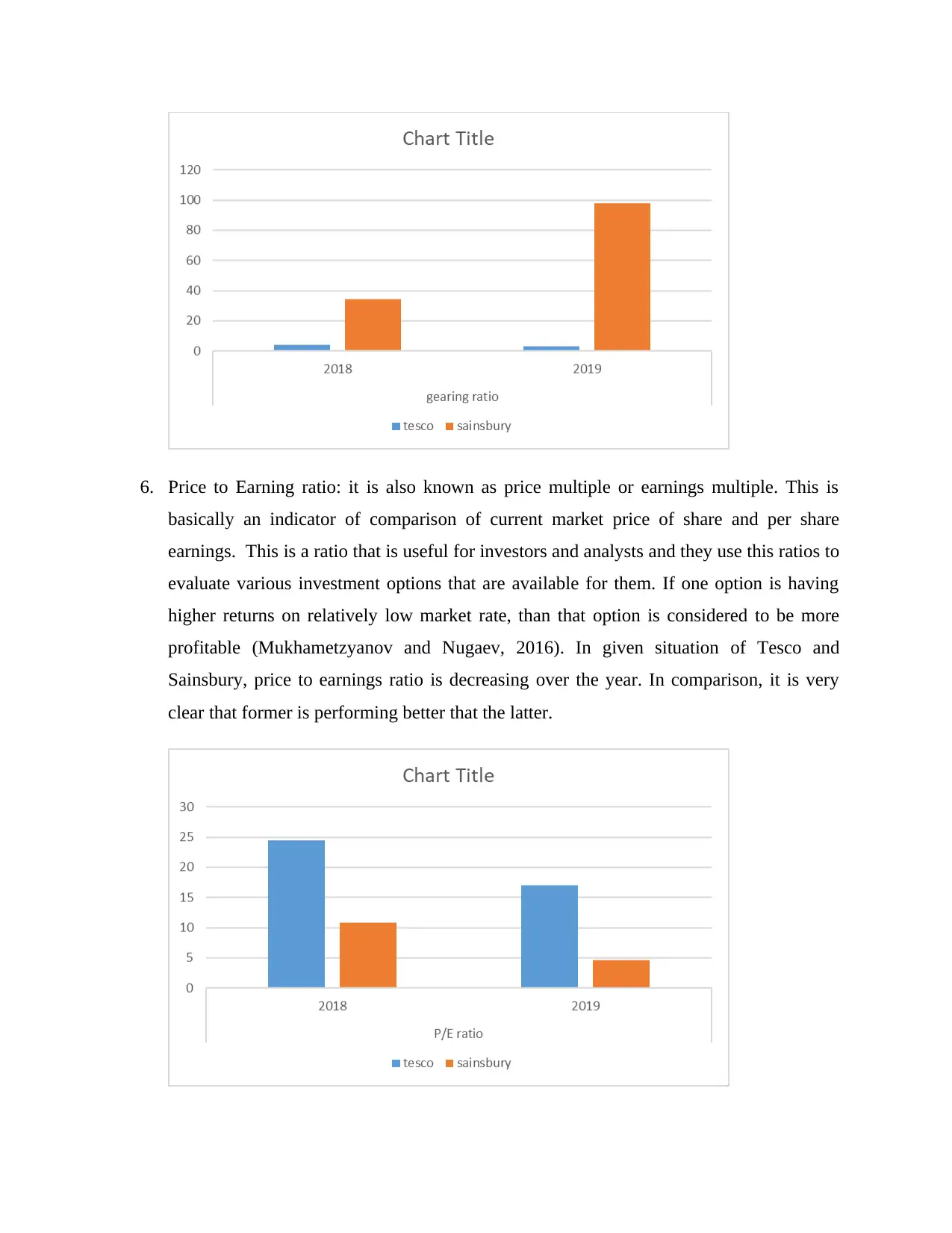
6. Price to Earning ratio: it is also known as price multiple or earnings multiple. This is
basically an indicator of comparison of current market price of share and per share
earnings. This is a ratio that is useful for investors and analysts and they use this ratios to
evaluate various investment options that are available for them. If one option is having
higher returns on relatively low market rate, than that option is considered to be more
profitable (Mukhametzyanov and Nugaev, 2016). In given situation of Tesco and
Sainsbury, price to earnings ratio is decreasing over the year. In comparison, it is very
clear that former is performing better that the latter.
basically an indicator of comparison of current market price of share and per share
earnings. This is a ratio that is useful for investors and analysts and they use this ratios to
evaluate various investment options that are available for them. If one option is having
higher returns on relatively low market rate, than that option is considered to be more
profitable (Mukhametzyanov and Nugaev, 2016). In given situation of Tesco and
Sainsbury, price to earnings ratio is decreasing over the year. In comparison, it is very
clear that former is performing better that the latter.
⊘ This is a preview!⊘
Do you want full access?
Subscribe today to unlock all pages.

Trusted by 1+ million students worldwide
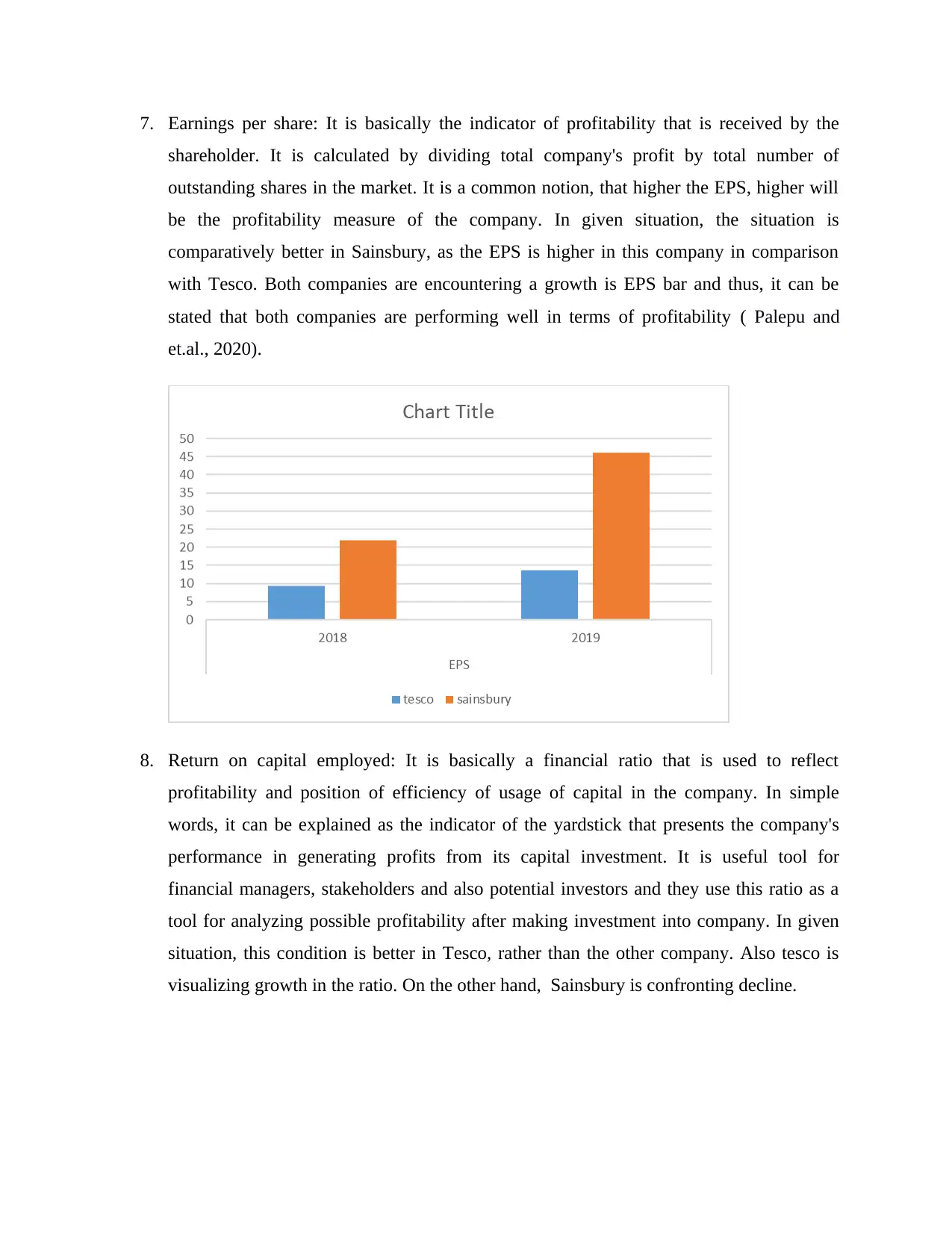
7. Earnings per share: It is basically the indicator of profitability that is received by the
shareholder. It is calculated by dividing total company's profit by total number of
outstanding shares in the market. It is a common notion, that higher the EPS, higher will
be the profitability measure of the company. In given situation, the situation is
comparatively better in Sainsbury, as the EPS is higher in this company in comparison
with Tesco. Both companies are encountering a growth is EPS bar and thus, it can be
stated that both companies are performing well in terms of profitability ( Palepu and
et.al., 2020).
8. Return on capital employed: It is basically a financial ratio that is used to reflect
profitability and position of efficiency of usage of capital in the company. In simple
words, it can be explained as the indicator of the yardstick that presents the company's
performance in generating profits from its capital investment. It is useful tool for
financial managers, stakeholders and also potential investors and they use this ratio as a
tool for analyzing possible profitability after making investment into company. In given
situation, this condition is better in Tesco, rather than the other company. Also tesco is
visualizing growth in the ratio. On the other hand, Sainsbury is confronting decline.
shareholder. It is calculated by dividing total company's profit by total number of
outstanding shares in the market. It is a common notion, that higher the EPS, higher will
be the profitability measure of the company. In given situation, the situation is
comparatively better in Sainsbury, as the EPS is higher in this company in comparison
with Tesco. Both companies are encountering a growth is EPS bar and thus, it can be
stated that both companies are performing well in terms of profitability ( Palepu and
et.al., 2020).
8. Return on capital employed: It is basically a financial ratio that is used to reflect
profitability and position of efficiency of usage of capital in the company. In simple
words, it can be explained as the indicator of the yardstick that presents the company's
performance in generating profits from its capital investment. It is useful tool for
financial managers, stakeholders and also potential investors and they use this ratio as a
tool for analyzing possible profitability after making investment into company. In given
situation, this condition is better in Tesco, rather than the other company. Also tesco is
visualizing growth in the ratio. On the other hand, Sainsbury is confronting decline.
Paraphrase This Document
Need a fresh take? Get an instant paraphrase of this document with our AI Paraphraser
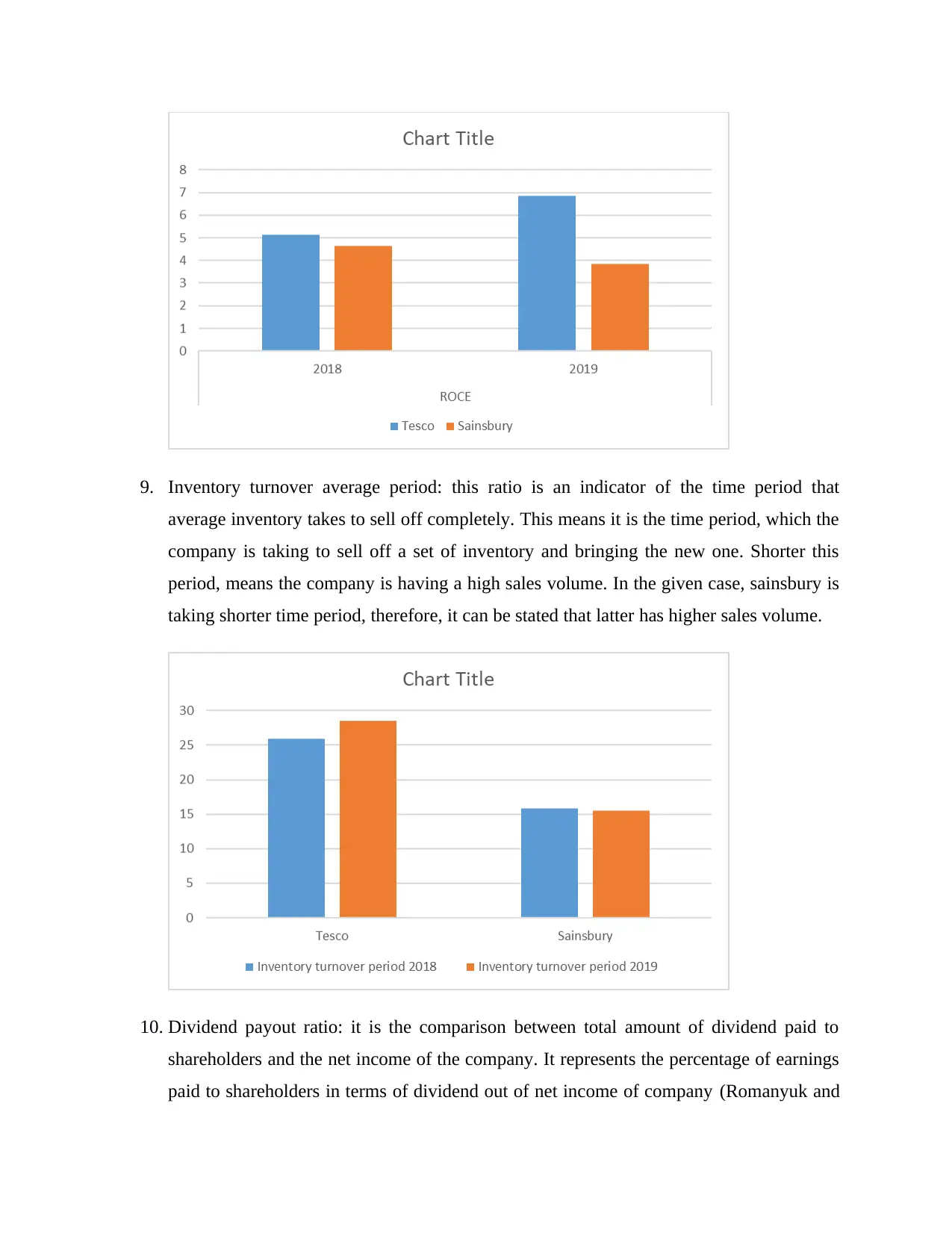
9. Inventory turnover average period: this ratio is an indicator of the time period that
average inventory takes to sell off completely. This means it is the time period, which the
company is taking to sell off a set of inventory and bringing the new one. Shorter this
period, means the company is having a high sales volume. In the given case, sainsbury is
taking shorter time period, therefore, it can be stated that latter has higher sales volume.
10. Dividend payout ratio: it is the comparison between total amount of dividend paid to
shareholders and the net income of the company. It represents the percentage of earnings
paid to shareholders in terms of dividend out of net income of company (Romanyuk and
average inventory takes to sell off completely. This means it is the time period, which the
company is taking to sell off a set of inventory and bringing the new one. Shorter this
period, means the company is having a high sales volume. In the given case, sainsbury is
taking shorter time period, therefore, it can be stated that latter has higher sales volume.
10. Dividend payout ratio: it is the comparison between total amount of dividend paid to
shareholders and the net income of the company. It represents the percentage of earnings
paid to shareholders in terms of dividend out of net income of company (Romanyuk and
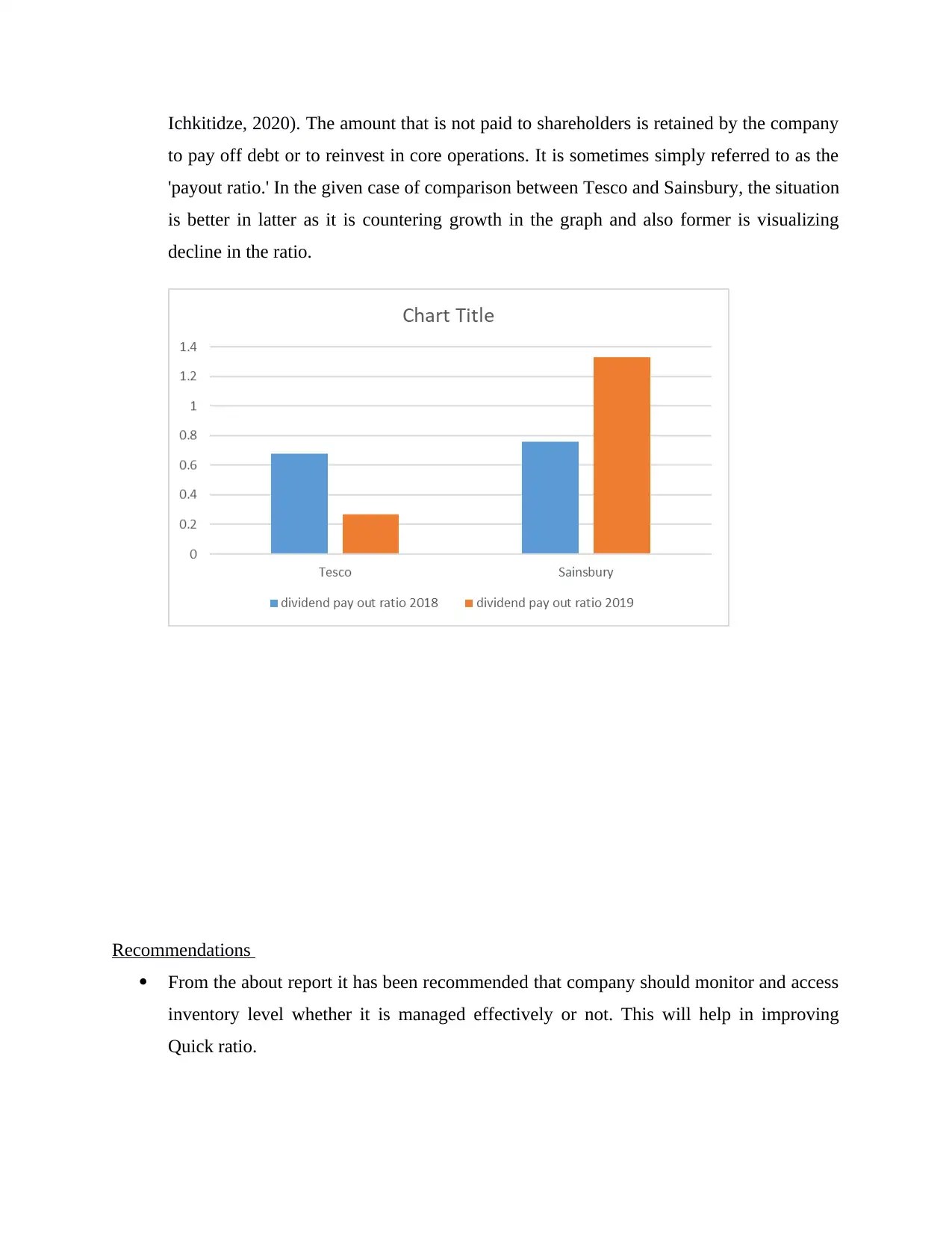
Ichkitidze, 2020). The amount that is not paid to shareholders is retained by the company
to pay off debt or to reinvest in core operations. It is sometimes simply referred to as the
'payout ratio.' In the given case of comparison between Tesco and Sainsbury, the situation
is better in latter as it is countering growth in the graph and also former is visualizing
decline in the ratio.
Recommendations
From the about report it has been recommended that company should monitor and access
inventory level whether it is managed effectively or not. This will help in improving
Quick ratio.
to pay off debt or to reinvest in core operations. It is sometimes simply referred to as the
'payout ratio.' In the given case of comparison between Tesco and Sainsbury, the situation
is better in latter as it is countering growth in the graph and also former is visualizing
decline in the ratio.
Recommendations
From the about report it has been recommended that company should monitor and access
inventory level whether it is managed effectively or not. This will help in improving
Quick ratio.
⊘ This is a preview!⊘
Do you want full access?
Subscribe today to unlock all pages.

Trusted by 1+ million students worldwide
1 out of 19
Related Documents
Your All-in-One AI-Powered Toolkit for Academic Success.
+13062052269
info@desklib.com
Available 24*7 on WhatsApp / Email
![[object Object]](/_next/static/media/star-bottom.7253800d.svg)
Unlock your academic potential
Copyright © 2020–2025 A2Z Services. All Rights Reserved. Developed and managed by ZUCOL.





